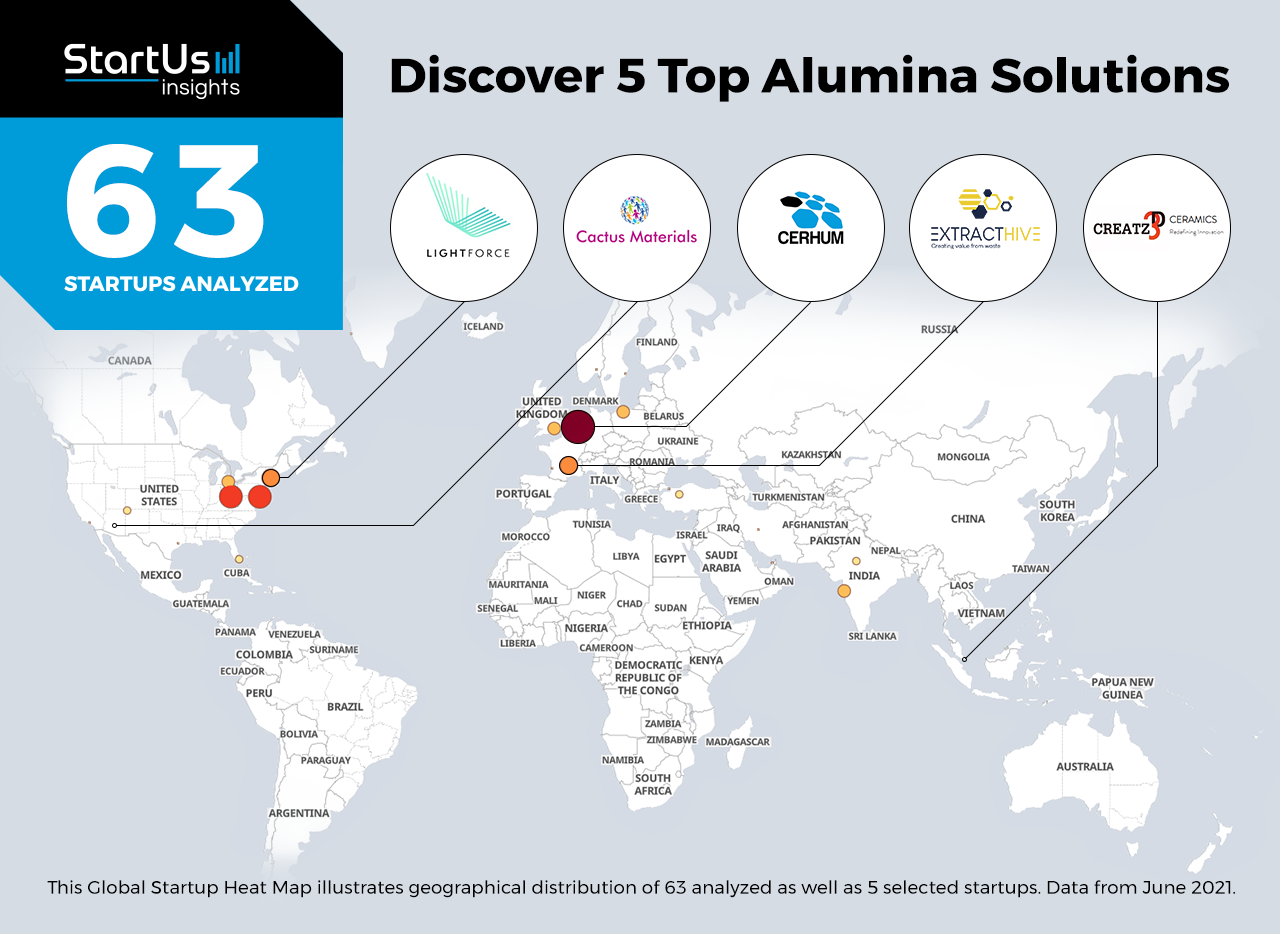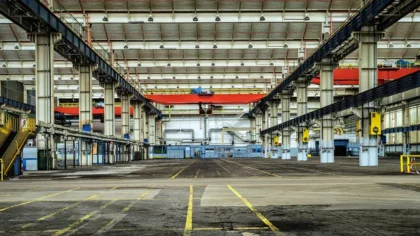Staying ahead of the technology curve means strengthening your competitive advantage. That is why we give you data-driven innovation insights into the materials industry. This time, you get to discover 5 hand-picked startups developing alumina solutions.
Global Startup Heat Map highlights 5 Top Alumina Solutions out of 63
The insights of this data-driven analysis are derived from the Big Data & Artificial Intelligence-powered StartUs Insights Discovery Platform, covering 2.093.000+ startups & scaleups globally. The platform gives you an exhaustive overview of emerging technologies & relevant startups within a specific field in just a few clicks.
The Global Startup Heat Map below reveals the distribution of the 63 exemplary startups & scaleups we analyzed for this research. Further, it highlights 5 materials startups that we hand-picked based on criteria such as founding year, location, funding raised, and more. You get to explore the solutions of these 5 startups & scaleups in this report. For insights on the other 58 alumina solutions, get in touch.
Cactus Materials provides Advanced Ceramics
Advanced ceramics such as alumina, zirconia, and silicon carbide find applications as alternatives to glass, metal, and plastics. Alumina possesses mechanical and electrical properties that make them suitable for applications in aerospace devices, flow meters, and pressure sensors, among others. To meet this demand, material startups produce alumina in varying grades of purity as well as different sizes and shapes.
US-based startup Cactus Materials is a manufacturer of semiconductor materials. The startup produces ceramic materials for furnace applications, semiconductor components, and 5G antennas. It customizes the materials to client specifications and offers silicon materials and aluminum nitride in addition to alumina. Cactus Materials also develops integrated circuited (IC) packaging and 2D materials.
CERHUM develops Bioceramics
Ceramic materials are tunable as replacements for hard tissues such as bone and teeth. Moreover, they are biologically inert, making them excellent optional biomaterials. To this end, startups use alumina to manufacture bioceramics for use in dental and bone implants. These implants possess a hydroxyapatite-like structure and intrinsic osteoinductive capacity, supporting the regeneration of tissues.
Belgian startup CERHUM combines additive manufacturing and advanced materials to manufacture medical devices. The startup builds dental screws, implants, crowns, braces, and bridges from alumina, its derivatives, and zirconia. Bioptos, the startup’s ceramic bone graft substitute, is 3D printed with optimized geometry. Additionally, the startup develops biomaterials for orthopedic, spinal, and joint cartilage applications.
Creatz3D Ceramics advances Ceramics 3D Printing
Technical ceramics possess good mechanical strength, thermal conductivity, and high electrical resistivity. Moreover, 3D printing enables the design and development of complex ceramic parts. However, machining ceramics is difficult due to their hardness and brittleness. This is why materials startups are focusing on 3D printing technologies that are more suited for ceramics.
Creatz3D Ceramics is a Singaporean startup that specializes in the 3D printing of ceramic parts. The startup uses laser stereolithography (SLA) to manufacture functional ceramics from alumina, zirconia, and other materials. It also provides rapid prototyping for concept modeling and performance optimization. Among others, the startup’s technical ceramics find applications for aerospace, biomedical, electronics, and energy purposes.
ExtractHive produces Refractory Materials
Refractory materials withstand very high temperatures and find applications in metallurgy, furnaces, and utility boilers. Due to its highly chemical stable nature, aluminium oxide is a popular choice for use as a refractory material. However, refractory materials are expensive thus limiting their use. To overcome this challenge, startups are working on solutions to recover refractory materials from spent industrial waste.
ExtractHive is a French startup that provides secondary materials for industrial processes. The startup collects used industrial materials and transforms them into materials with low environmental impact. It offers services for composite materials recycling, metal valorization, and wastewater treatment. In addition to alumina, ExtractHive offers other advanced materials, including chromium oxide, silicon carbide, and carbon fibers.
LightForce manufactures Orthodontics
Alumina is a good candidate for orthodontic material due to its strength and hardness. However, its brittle nature increases the risk of cracks. Material startups are working on new methods to develop biomedical grade alumina that address this limitation. These include developing alumina composites and refining the microstructure of alumina to make it more suitable for dental applications, for instance.
US-based startup LightForce creates 3D-printed orthodontics. The startup’s Cloud brackets are composed of ceramic polycrystalline alumina and custom-made for each patient. It is further customizable with distal hooks on upper lateral incisors, cuspids, and bicuspids. The startup also offers orthodontics for patient-specific indirect bonding and bite correction.
Discover more Materials Startups
Materials startups such as the examples highlighted in this report focus on nanotechnology, advanced composites, smart materials as well as sustainability. While all of these technologies play a major role in advancing the materials industry, they only represent the tip of the iceberg. To explore more materials technologies, simply get in touch to let us look into your areas of interest. For a more general overview, you can download our free Materials Innovation Report to save your time and improve strategic decision-making.









